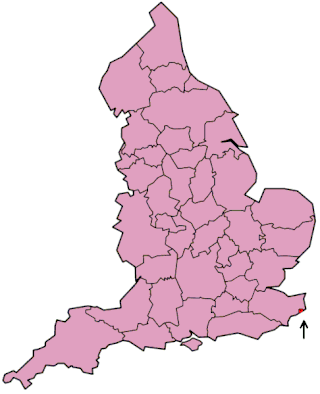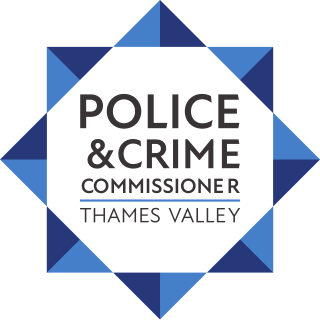
The City of London is a city, ceremonial county and local government district that contains the historic centre and constitutes, alongside Canary Wharf, the primary central business district (CBD) of London. It constituted most of London from its settlement by the Romans in the 1st century AD to the Middle Ages, but the modern area named London has since grown far beyond the City of London boundary. The City is now only a small part of the metropolis of Greater London, though it remains a notable part of central London. Administratively, the City of London is not one of the London boroughs, a status reserved for the other 32 districts. It is also a separate ceremonial county, being an enclave surrounded by Greater London, and is the smallest ceremonial county in the United Kingdom.

Thames Valley Police is the territorial police force responsible for policing the Thames Valley, covering the counties of Berkshire, Buckinghamshire and Oxfordshire in South East England. It is the largest non-metropolitan police force in England and Wales, covering 2,218 square miles (5,740 km2) and a population of 2.42 million people.
"Adam" was the name police gave to an unidentified male child whose torso was discovered in the River Thames in London, United Kingdom, on 21 September 2001. Investigators believe the child was likely from southwestern Nigeria, and that several days before his murder, he was trafficked to the United Kingdom for a muti ritual sacrifice. To date, nobody has been charged with Adam's murder, and his true identity remains unknown.

Cambridgeshire Constabulary is the local territorial police force that covers the county of Cambridgeshire and Peterborough unitary authority. It provides law enforcement and security for an area of 1,311 square miles (3,400 km2) and population of 856,000 people, in a predominantly rural county. The force of Cambridgeshire includes the cities of Cambridge, Ely and Peterborough, the market towns of Chatteris, Huntingdon, March, Ramsey, St Ives, St Neots, Whittlesey, and town and Port of Wisbech. Its emblem is a crowned Brunswick star containing the heraldic badge of Cambridgeshire County Council.

The Civil Nuclear Constabulary (CNC) is a special police force responsible for providing law enforcement and security at any relevant nuclear site and for security of nuclear materials in transit within the United Kingdom. The force has over 1,500 police officers and support staff. Officers within the force are authorised firearms officers, due to the nature of the industry the force protects.

Thames House is an office building in Millbank, London, on the north bank of the River Thames adjacent to Lambeth Bridge. Originally used as offices by Imperial Chemical Industries (ICI), it has served as the headquarters of the United Kingdom's internal Security Service since December 1994. It also served as the London headquarters of the Northern Ireland Office (NIO) until March 2013.
The Kew Constabulary is a small, specialised constabulary responsible for policing the Royal Botanic Gardens at Kew in Richmond-upon-Thames, England.

The Port of Tilbury Police is a non-Home Office ports police force responsible for the Port of Tilbury, and Tilbury 2 owned by the Port of Tilbury London Ltd, a subsidiary of Forth Ports plc. The force consists of a Chief of Police, Police Inspector, three Police Sergeants and ten Police Constables.

The Metropolitan Police Act 1839 is an Act of the Parliament of the United Kingdom. The Act enlarged the district of, and gave greatly increased powers to the Metropolitan Police established by the Metropolitan Police Act 1829. It is one of the Metropolitan Police Acts 1829 to 1895.

The Oxford University Police, or Oxford University Constables, was the private police force of the University of Oxford between 1829 and 2003. They carried warrant cards and were empowered to act as police officers within the University precincts and within areas of Oxford within four miles of any University building. As of 2001 the force existed as a private constabulary with 40 sworn constables. They were widely recognised for the bowler hats which formed part of their uniform, and formerly had the duty of patrolling outside the Examination Schools alongside the University Proctors, the officials responsible for discipline in the University. They were abolished by the University Council in 2003.
A specialist firearms officer (SFO) is a British police officer who has undergone training in the use of police firearms to a more advanced level than authorised firearms officers (AFOs). SFOs receive additional training in areas such as building assault and specialist weapon usage. The common role of an SFO is to assault premises involved in a siege situation, effect high-risk firearms related arrests and respond to terrorist threats.

The Thames Valley Police and Crime Commissioner (PCC) is a police and crime commissioner, an elected official tasked with setting out the way crime is tackled by Thames Valley Police in the ceremonial English counties of Berkshire, Buckinghamshire and Oxfordshire. The post was created in November 2012, following an election held on 15 November 2012, and replaced the Thames Valley Police Authority. The current incumbent is Matthew Barber, who represents the Conservative Party.
Henley Borough Police was the police force responsible for policing the borough of Henley in Oxfordshire, England until 1856.
Windsor Borough Police was the police force responsible for policing the borough of Windsor in Berkshire, England until 1947.
Wantage Borough Police was the police force responsible for policing the town of Wantage in Berkshire, England until 1856.

Counter Terrorism Policing is the national collaboration of police forces working to prevent, deter, and investigate terrorism in the United Kingdom.

The Act 39 & 40 Geo. 3. c. 87, sometimes called the Thames Police Act 1800, the Thames River Police Act 1800, the Marine Police Act or the Depredations on the Thames Act 1800, was an Act of the Parliament of Great Britain, granted royal assent on 28 July 1800. As alluded to in its long title, it amended the Thefts upon the Thames Act 1762.











